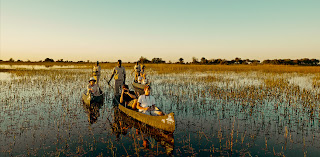A water camp is located deep in Botswana's Okavango Delta (the world's largest inland delta) and is seasonally, and sometimes year-round, surrounded by lagoons, networks of waterways and rivers. Water camps are usually built on stilts and have bridges connecting the tents or rooms with the shared public areas. Often guests can sit on a private verandah outside of their room and enjoy views overlooking the water.
Activities at water camps are a bit different than at "land" camps. Thanks to the flow of shallow waterways, mokoros are an ideal way to explore the Delta from water camps. Mokoros are traditional-style dug out canoes that are taken out in shallow water, allowing travelers to see the smaller things in Africa - birds, frogs and plant life. The goal of a mokoro ride is to enjoy the silence of skimming through the water without a motor, rather than viewing big game. Motor boat cruises are also available at water camps; this outing does often provide an opportunity to spot game. Finally, when on a small island in the Delta as many water camps are, walking is a unique experience and a great way to learn more about wildlife tracks, birds and bugs. The smaller things are just as interesting as the bigger ones!

Birding and game viewing at water camps is excellent. Pell's fishing owl are common near water areas; lechwe and sitatunga are antelope species that have adapted to the water; elephants often gather near waterways during drier months.
Some of our favorite water camps are Jacana Camp, Little Vumbura Camp, Jao Camp, Camp Okavango and Xugana Island Lodge. Ask Africa Easy to design a custom itinerary to include these camps or book our Best of Botswana Safari.
Photos by Africa Easy and Desert & Delta.




